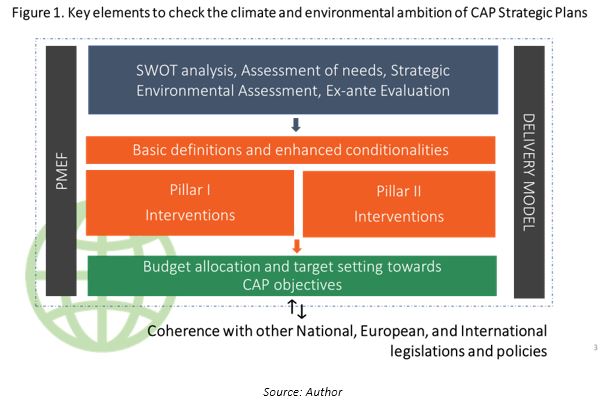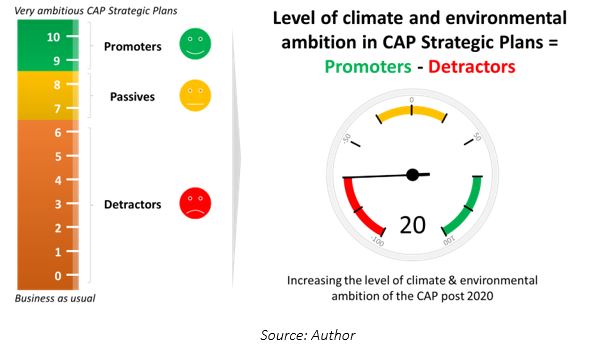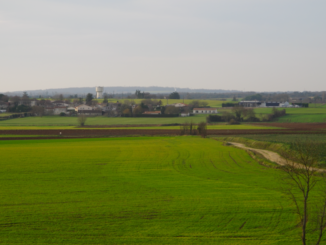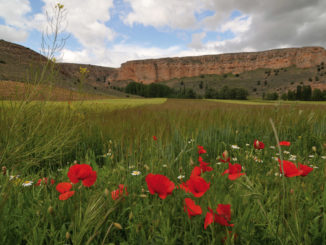Climate and environment will rightly form a huge part of how the next CAP is framed – but the process for developing and checking relevant criteria is unclear. Here’s how we can help with that.
The concept of climate and environmental ambition of the future CAP Strategic Plans is multidimensional, yet clear criteria for guiding a transparent appraisal and approval process are still missing. The article provides a framework and examples of guiding questions to check this concept in all the elements of the CAP Strategic Plans.
These is already a “no backsliding” principle – Art. 92 of the Strategic Plan Regulation – so a lack of clear criteria goes against this. The level of ambition will also be led by both the EU institutions and the Member States in different ways, at different times. To this end, the accompanying document to the EU Farm to Fork and Biodiversity Strategies. Different actors will act as promoters, passives, or detractors in this process until the final CAP Strategic Plans’ approval and beyond. Arc2020 project on #CAP Strategic Plans will continue to foster a large dialogue across the EU. Stakeholders and scientists are invited to share their views on the progress made by the Member States in designing the CAP Strategic Plans and to send their answers or observations to the guiding questions outlined in this article.
Introduction
Last week´s publication of the Farm to Fork and Biodiversity Strategies marked an important turning point in the CAP reform, at EU and national level. As expected, the European Green Deal will play a crucial role in the preparation and approval of the National CAP Strategic Plans, including other factors that have hit the reform process started in 2018 (e.g. Election of EU Parliament, Brexit, MFF negotiations, COVID-19).
With a frozen CAP reform process for one to two years (CAP transitional provisions), there is further scope for revision of content, deliverables and implementation of the CAP reform which should be used to intensify debates and suggestions for improvements
To meet the targets and vision outlined in the European Green Deal, the Commission published an analysis of the links between it and the CAP Reform, which we’ve done an analysis of. There are various innovative elements presented in this analysis, which can potentially improve the basic CAP reform text (e.g. minimum ring-fenced spending for Pillar I eco-schemes). The analysis also emphasised increasing the overall level of climate and environmental ambition of the future CAP Strategic Plans, and the role of the Commission itself in the preparatory process, which will be “further reinforced” because of the EU Green Deal.
With higher flexibility for the Member States to design and deliver CAP Strategic Plans, the question of ‘how can we ensure higher levels of climate and environmental ambition in the Member States?’ remains shrouded by doubts and reasonable scepticism. Two years after its reform proposal in June 2018, the Commission still has no straightforward and operational answers for this complex question.Criteria to approve the CAP Strategic Plans
The Commission is so aware of the lack of transparency and clarity laid out for the approval process of the CAP Strategic Plans that a specific section of the analysis between the CAP reform and the European Green Deal was exclusively dedicated to this aspect (see Section 3.4.1 Increase transparency in the approval process of CAP Strategic Plans).
In this section, the Commission explains that CAP Strategic Plans will be approved based on five broad criteria, including also one about ‘their consistency and coherence with the CAP reform regulations’. Considering the gaps in terms of transparency and stakeholder inclusion along the design process of the CAP Strategic Plans observed in some Member States, the outlined criteria proposed by the Commission continue to raise the suspense instead of urgently take actions and steer the design process towards clear criteria.
It is expected that the Commission will strictly enforce various articles of the proposal for CAP Strategic Plans Regulation, specifically:
- 92 Increased ambition with regard to environmental- and climate-related objectives
- 94 Procedural requirements, which call the Member States to adopt transparent procedures in the design process
How can we check the level of climate and environmental ambition of the CAP Strategic Plans?
To answer this question, scientists, NGOs, the European Court of Auditors, and civil society organisations have not been waiting ‘a braccia conserte’ so far (trad: waiting passively with arms folded). An extensive body of literature, scientific articles, workshops and meetings have put forward specific requests to the Commission and Member States.
One of the main messages coming out from this collective work is that the level of climate and environmental ambition should be checked – assessed – in multiple elements of the CAP Strategic Plans. This is also confirmed by the Commission’s analysis of the links with the European Green Deal (Page 17). To make a quantitative and qualitative judgment about the level of climate and environmental ambition of the CAP Strategic Plan, the following key elements need to be carefully scrutinised (Figure 1).
Our Arc2020 project on #CAP Strategic Plans calls NGOs, scientists, civil society organisations working in the Member States to look together at these elements throughout the designing process of the CAP plans.
1. Starting from the SWOT analysis, assessment of needs, SEA, ex-ante evaluation
While in some countries these are considered merely as ‘symbolic’ exercises, these steps are the building blocks of the future CAP Strategic Plans. They can pave the way and justify important decisions in the final plans. It is important to answer key guiding questions, for instance:
- Has the SWOT analysis been comprehensive, and covered all territorial aspects related to the environment and climate (e.g. soil erosion, industrial meat production, use of antibiotics in farm animals, water and air pollution)? Have all agri-food sectors been included? This is especially important as it is a building block for later stages.
- Has the SWOT analysis looked also at the synergies and tensions among the territorial aspects analysed under each CAP Specific Objectives?
- Has the Strategic Environmental Assessment expert been appointed in a transparent way since the early stages of the design process of the CAP Strategic Plan?
2. Basic definitions and enhanced conditionality
The “essential is invisible to the eye” Antoine de Saint-Exupéry (Le Petit Prince). Anyone who has ever signed an agreement can confirm how important the contractual conditions are! For the purpose of analysing the level of environmental ambition, it is important to check for instance:
- Have additional standards been prescribed to those laid down in Annex III of the Commission proposal, Art. 12(2)?
- Have standards been retained under conditionalities or have they been moved to ecoschemes?
- Have clear and updated procedures been established to monitor, on a large scale, farmer compliance to the enhanced conditionality?
- Has a system for providing the Farm Sustainability tool for Nutrients been established?
3. Pillar I and II interventions: all together
While Pillar I and II interventions can be addressed individually, to draw conclusions on the overall level of environmental ambition, these two key elements need to be checked systematically and all together. Under Pillar I, we suggest answering the following questions:
- Have direct payments been designed with a view to reward sustainable food production methods and the provision of public goods (e.g. biodiversity protection, maintenance of soil carbon stock, genetic diversity of plant and animal reproductive material, forest fire prevention)?
- Have coupled direct payments to harmful and intensive production systems been cancelled or re-qualified with environmental and climate criteria?
- Have new eco-schemes and direct payments been designed with a bottom-up approach, g. discussed and tested with farmers to analyse their motivations to participate, as well as to test their efficiency and effectiveness to deliver public goods?
- Has a new infrastructure supporting diversification of production been included, favouring extensive crop rotation, mixed farming systems, leguminous crops and short inputs and nutrient cycles?
Similarly, for Pillar II interventions, the following questions can be checked in the CAP Strategic Plans:
- Have Agri-Environment-Climate commitments been discussed, designed, and tested with a bottom-up approach?
- Has double funding been avoided between Pillar I Eco-schemes and Pillar II AEC commitments?
- Has the support to AEC commitments been paired up with farm advisory services to help farmers meeting the commitments?
- Has a spatial planning or landscape-level implementation been used to design, target, and monitor the performance of 1) interventions for AEC commitments, 2) payments for areas with natural constrains and 3) payments for areas with specific disadvantages resulting from mandatory requirements?
4. Budget allocation and target setting
Finance is pivotal for backing up a climate and environmentally ambitious CAP Strategic Plans. This can be checked by answering key questions, like:
- Has the budget flexibility in the Member State been used to increase the budget to targeted payments for public goods in Pillar 2?
- Has a significant budget been ringfenced for climate and environmental interventions in both CAP Pillars?
- Has a minimum budget been allocated for testing innovative interventions, like result-based payments, collaborative implementation, auction models for the provision of AECM?
- Have the baselines been clearly set up for measuring the achievements towards annual milestones and targets?
5. Performance Monitoring and Evaluation Framework
The PMEF is certainly complex – and unless you sit in one of the Council working meetings or Commission offices, you will have hard time getting your say (See more on this here). In any case, the philosophy of the PMEF will always be the same: ‘Member States can develop their own national evaluation plan complementary to the common PMEF’. Therefore, the key questions are the following:
- Has an additional data and indicator system been developed complementarily to the common PMEF at EU level, particularly to assess the CAP environmental effects (not only delivery performance) on biodiversity, water, soil, emissions, etc.?
- Have the gaps in common list of indicators in the common PMEF been filled up with national and regional indicators aligned with all 17 SDGs goals?
- Have specific evaluation questions and methodologies been developed at the early stage of the CAP Strategic Plans to assess the tradeoffs and negative tensions of multiple CAP interventions on the environment, society, and rural economy?
6. Delivery model
In the name of ‘higher flexibility and subsidiarity principle’ for the Member States, higher climate and environmental ambition means answering questions like:
- Have approaches to reduce the administrative costs of agri-environmental benefits been designed in the CAP SPs, with a view to reaching higher levels of efficiency and effectiveness?
- Have environmental Pillar II interventions delegated to regional authorities been designed and based on regional SWOT analysis and assessment of needs?
7. Coherence with other National, European, and International legislations and policies
Someone calls it: “the big picture”. Others call it: ‘external coherence’. The element is about checking how the CAP Strategic Plans align and address other National, European, and International targets, legislation and policies. Annex XI to the Commission proposal provides an initial list of EU legislation concerning the environment and climate. To this, the Farm to Fork and Biodiversity strategies targets and actions need to be considered in the CAP Strategic Plans.
Finally, while this list of guiding questions can be further extended or specified in more details, we encourage their application when appraising the CAP Strategic Plans throughout the designing and ex ante evaluation phases.
What role can you play in the designing process?
With the transitional provisions slowing down the CAP reform process, much can be done to play an active and promoting role supporting the Member States until the final adoption of the CAP Strategic Plans. In this process, it is important to act as promoter in all its possible forms: exchanging good practices among the Member States, backing up ambitious targets and working on solutions to improve or achieve them, actively participating in transparent dialogues between the Commission and the Member States, following Council’s working meetings and supporting preparations in the trilogues.
A promoting role means turning external events like COVID-19 into an opportunity to change for the better. This work is against detractors who continue to water down and increase the level of vagueness of the CAP Strategic Plans. Detractors use the challenges towards a greener agriculture as arguments to backslide the CAP, postponing reforms, or remarking short terms trade-offs between the environment and the economic dimensions of the farmers, instead of working on urgent and long-term solutions. Which role would you like to play?
Conclusions
Here Arc2020 has analysed the implications of the CAP reform and the links with the European Green Deal on the CAP Strategic Plans. The concept of climate and environmental ambition is multidimensional. It needs to be addressed in all the elements of the CAP Strategic Plans. A lack of clear criteria set up at EU level can negatively compromise the “No backsliding” principle of the CAP reform. The level of ambition is also a dual playfield in continuous development between the EU institutions and the Member States. Different actors will act as promoters, passives, or detractors in this process until the final plans’ adoption and beyond.
Our Arc2020 project on #CAP Strategic Plans will continue to foster a large dialogue across the EU. Stakeholders and scientists are invited to share their views on the progress in designing the CAP Strategic Plans in the Member States, and to send their answers or observations on the key questions outlined in this article.
References
- Pe’er, G., Bonn, A., Bruelheide, H., Dieker, P., Eisenhauer, N., Feindt, P. H., … & Marquard, E. (2019). Action needed for the EU Common Agricultural Policy to address sustainability challenges. People and Nature.
- Lampkin N, Stolze M, Meredith S, de Porras M, Haller L, Mészáros D (2020) Using Eco-schemes in the new CAP: a guide for managing authorities. IFOAM EU, FIBL and IEEP, Brussels.
- European Commission (2020) Analysis of links between CAP Reform and Green Deal. Commission Staff Working Document. Brussels.
- Scown, M. W., & Nicholas, K. A. (2020). European agricultural policy requires a stronger performance framework to achieve the Sustainable Development Goals. Global Sustainability, 3.
- Schroeder, L. A., Isselstein, J., Chaplin, S., & Peel, S. (2013). Agri-environment schemes: Farmers’ acceptance and perception of potential ‘Payment by Results’ in grassland—A case study in England. Land Use Policy, 32, 134-144.
download this artice as a PDF
 This article is produced in cooperation with the
This article is produced in cooperation with the
Heinrich Böll Stiftung European Union.
More on CAP Strategic Plans
How Transparent and Inclusive is the Design Process of the National CAP Strategic Plans?
Series | What will come from the CAP Strategic Plan Negotiations?









1 Trackback / Pingback
Comments are closed.